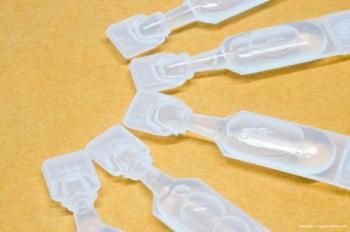
- Ophthalmology Times: September 2024
- Volume 49
- Issue 9
Transforming the eye with a new standard for corneal cross-linking
The new standard: Stabilizing keratoconus and improving vision.
Corneal cross-linking (CXL) has transformed the disease course of patients with corneal ectasias since its introduction to clinical practice in 2002. But what CXL had not been designed to achieve was improvements in visual outcomes.
The original (and until recently, gold standard) CXL protocol for ectasia has, for most of this time, been the Dresden protocol.1 It involves epithelium removal and 20 minutes of riboflavin application, followed by 30 minutes of UV light irradiation at 3 mW/cm² to deliver a total fluence of 5.4 J/cm². Dresden protocol cross-linking might flatten the cornea by a small amount—often in the range of 1.5 D—but this flattening is too small to make a meaningful difference to the vision of patients with corneal ectasias who undergo the procedure.
But CXL has moved on. We know that oxygen diffusion into the stroma is an essential—and rate-limiting—step in the UV-riboflavin photochemical reaction, and that accelerating the delivery of the 5.4 J/cm² fluence results in a reduction in the stiffening effect.2-5 The essential role of oxygen also explains why many of the older epithelium-on (epi-on) CXL protocols delivered a poorer corneal stiffening effect than epi-off protocols3: The epithelium consumes oxygen and absorbs UV energy.5-8 Today, modern, higher-fluence (up to 10 J/cm²) protocols are set to close this efficacy gap.9 Learnings made during these developments prompted a rethinking of how corneal flattening might be achieved.
The evolution of customized cross-linking
The first generation of customized cross-linking employed the following approach: delivering gradients of UV energy fluences over an epi-off cornea with the highest fluence over the tomographically largest bulging of the posterior cornea. This tomography-guided pattern generates more cross-links over the tip of the keratoconus and a greater flattening.10
To achieve the effect, surgeons have to use a UV-A delivery device with an integrated eye tracker that can deliver the different UV fluences to different parts of the cornea, rather than using a regular cross-linking device that delivers a uniform fluence across the cornea.11 Even so, the flattening effects were only moderately predictable: approximately 2 to 4 D in total,12-14 even when using adjuncts like supplemental oxygen to improve the cross-linking effect.15
ELZA-PACE customized CXL: The next generation
The ELZA Institute has developed a second-generation customized cross-linking method, called ELZA phototherapeutic keratectomy (PTK)–assisted customized epi-on cross-linking (PACE). ELZA-PACE is a mixture of ELZA’s new epi-on CXL (which needs neither iontophoresis nor additional oxygen) and an epi-off area over the center of the keratoconus.
The epi-off area is created using an excimer laser PTK. The PTK is tailored to the center of the keratoconus cone, respecting the individual epithelial thickness profile of that area, thus entirely preserving the stromal tissue—and this brings with it a corresponding impact on oxygen and UV energy penetration into the stroma.
Following the epithelial map-driven PTK, a penetration-enhancer is applied, followed by the riboflavin we developed, which establishes a riboflavin concentration gradient that peaks at the cone. In addition, a greater amount of UV irradiation is applied over the cone area and less over the peripheral regions of the cornea during cross-linking (Figure).
Taken together, this generates 3 gradients: UV fluence, riboflavin, and oxygen, as opposed to the one gradient (UV fluence) generated by the earlier, first-generation approach.
Clinical outcomes and patient benefits
Initial findings show a flattening effect significantly stronger than that achieved by earlier generations of customized CXL. Most interestingly, not only did we observe maximum keratometry (Kmax) reductions of 4 to 5 D within the first postprocedure month, but we also saw a steepening of the opposing superior area of several diopters, due to a coupling effect. Taking these 2 effects together, we often see a marked improvement in the symmetry of the astigmatism.
These changes lead to improvements in the wavefront errors and thus an increase in corrected distance visual acuity with glasses. Over 6 months to a year, PACE often achieves 8 to 12 D of total asymmetry reduction and, in some cases, a gain of corrected distance visual acuity with glasses of up to 6 lines. This regularization of the corneal surface is achieved by remodeling only, all without removing stromal tissue.
Can PACE be performed with a manual abrasion?
We tried and failed to see a similar effect when performing PACE with a manual abrasion. The reason is that the abrasion has to be tailored around the tip of the keratoconus using a specific topographic map. Doing this manually would mean transferring a specific abrasion offset in the range of 20 µm onto the cornea, and performing an abrasion that includes the area of interest within a few micrometers.
Ideal candidates for ELZA-PACE
Patients with corneal ectasias with Kmax values in the range of 50 to 60 D are excellent candidates for ELZA-PACE. The marked flattening over the cone shifts the patient’s refraction toward hypermetropia. The patients should therefore be at least mildly myopic to begin with. Also, the classic bow tie keratoconus pattern responds better to ELZA-PACE than other topographical forms.
ELZA-PACE can be used not only in progressive keratoconus but also in stable keratoconus: A typical example would be a 35-year-old patient with stable keratoconus who had been using contact lenses for almost 20 years and who started developing contact lens intolerance.
We avoid performing ELZA-PACE in K readings below 50 D, because we might theoretically encounter slow and long-term flattening. So having a starting point that is beyond 50 D will prevent the cornea from flattening into nonphysiological values.
ELZA-PACE can be combined with other treatments such as the use of intracorneal ring segments (such as the all-Femto-CAIRS [corneal allogenic intrastromal ring segments] procedure by Soosan Jacob, DNB, MS, FRCS, and Shady Awwad, MD, that uses allogenic corneal tissue) and corneal wavefront-guided photorefractive keratectomy.
When will ELZA-PACE be available?
Our method is based on our new epi-on CXL protocol. During epi-on CXL, we pretreat the cornea with special drops that enhance the penetration of riboflavin. These penetration enhancers are the result of several years of research and are currently awaiting the CE mark.
Once the CE mark is given, ELZA-PACE can be performed by any colleague equipped with an MS-39 device for the epithelial maps and generation of the ablation file (CSO Italy), a SCHWIND AMARIS excimer laser for the custom PTK driven by epithelial maps (SCHWIND-eye-tech-solutions GmbH), and the C-eye cross-linking technology for customized CXL (EMAGine Switzerland).
Conclusion
ELZA-PACE represents a significant advancement in keratoconus treatment without the need for corneal tissue removal. By leveraging the combined gradients of riboflavin, oxygen, and UV irradiation, ELZA-PACE achieves outcomes that surpass those of first-generation customized cross-linking. As ophthalmologists, we must consider ELZA-PACE as a first-line visual rehabilitation option for patients with keratoconus, ensuring they receive the most effective and advanced care available.
Farhad Hafezi, MD, PhD, FARVO
E: [email protected]
Hafezi is a refractive and cataract surgeon based at the ELZA Institute in Zurich, Switzerland. Hafezi is a council member of the European Society of Cataract & Refractive Surgeons and holds academic positions at the University of Geneva, the Keck School of Medicine of the University of Southern California, the New York University Grossman School of Medicine, and Wenzhou Medical University. Financial disclosures: EMAGine AG (shareholder); PCT patent/application holder (corneal apparatus for CXL).
References:
Wollensak G, Spoerl E, Seiler T. Riboflavin/ultraviolet-a-induced collagen crosslinking for the treatment of keratoconus. Am J Ophthalmol. 2003;135(5):620-627. doi:10.1016/s0002-9394(02)02220-1
Richoz O, Hammer A, Tabibian D, Gatzioufas Z, Hafezi F. The biomechanical effect of corneal collagen cross-linking (CXL) with riboflavin and UV-A is oxygen dependent. Transl Vis Sci Technol. 2013;2(7):6. doi:10.1167/tvst.2.7.6
Hammer A, Richoz O, Arba Mosquera S, Tabibian D, Hoogewoud F, Hafezi F. Corneal biomechanical properties at different corneal cross-linking (CXL) irradiances. Invest Ophthalmol Vis Sci. 2014;55(5):2881-2884. doi:10.1167/iovs.13-13748
Kling S, Richoz O, Hammer A, et al. Increased biomechanical efficacy of corneal cross-linking in thin corneas due to higher oxygen availability. J Refract Surg. 2015;31(12):840-846. doi:10.3928/1081597X-20151111-08
Torres-Netto EA, Kling S, Hafezi N, Vinciguerra P, Randleman JB, Hafezi F. Oxygen diffusion may limit the biomechanical effectiveness of iontophoresis-assisted transepithelial corneal cross-linking. J Refract Surg. 2018;34(11):768-774. doi:10.3928/1081597X-20180830-01
Freeman RD. Oxygen consumption by the component layers of the cornea. J Physiol. 1972;225(1):15-32. doi:10.1113/jphysiol.1972.sp009927
Harvitt DM, Bonanno JA. Oxygen consumption of the rabbit cornea. Invest Ophthalmol Vis Sci. 1998;39(2):444-448.
Seiler TG, Komninou MA, Nambiar MH, Schuerch K, Frueh BE, Buchler P. Oxygen kinetics during corneal cross-linking with and without supplementary oxygen. Am J Ophthalmol. 2021;223:368-376. doi:10.1016/j.ajo.2020.11.001
Abrishamchi R, Abdshahzadeh H, Hillen M, et al. High-fluence accelerated epithelium-off corneal cross-linking protocol provides Dresden protocol-like corneal strengthening. Transl Vis Sci Technol. 2021;10(5):10. doi:10.1167/tvst.10.5.10
Kanellopoulos AJ, Dupps WJ, Seven I, Asimellis G. Toric topographically customized transepithelial, pulsed, very high-fluence, higher energy and higher riboflavin concentration collagen cross-linking in keratoconus. Case Rep Ophthalmol. 2014;5(2):172-180. doi:10.1159/000363371
Wu D, Lim DK, Lim BXH, et al. Corneal cross-linking: the evolution of treatment for corneal diseases. Front Pharmacol. 2021;12:686630. doi:10.3389/fphar.2021.686630
Seiler TG, Fischinger I, Koller T, Zapp D, Frueh BE, Seiler T. Customized corneal cross-linking: one-year results. Am J Ophthalmol. 2016;166:14-21. doi:10.1016/j.ajo.2016.02.029
Nordström M, Schiller M, Fredriksson A, Behndig A. Refractive improvements and safety with topography-guided corneal crosslinking for keratoconus: 1-year results. Br J Ophthalmol. 2017;101(7):920-925. doi:10.1136/bjophthalmol-2016-309210
Cassagne M, Pierné K, Galiacy SD, Asfaux-Marfaing MP, Fournié P, Malecaze F. Customized topography-guided corneal collagen cross-linking for keratoconus. J Refract Surg. 2017;33(5):290-297. doi:10.3928/1081597X-20170201-02
Mazzotta C, Sgheri A, Bagaglia SA, Rechichi M, Di Maggio A. Customized corneal crosslinking for treatment of progressive keratoconus: clinical and OCT outcomes using a transepithelial approach with supplemental oxygen. J Cataract Refract Surg. 2020;46(12):1582-1587. doi:10.1097/j.jcrs.0000000000000347
Articles in this issue
about 1 year ago
AAO 2024 to “elevate” in Windy Cityabout 1 year ago
Expanding the range of vision with monofocal IOLsabout 1 year ago
ASRS offers a taste of Swedenabout 1 year ago
Tapping metabolomics for timely detection of glaucoma casesabout 1 year ago
Untangling the genetic secrets of retinoblastomaNewsletter
Don’t miss out—get Ophthalmology Times updates on the latest clinical advancements and expert interviews, straight to your inbox.



















































.png)


